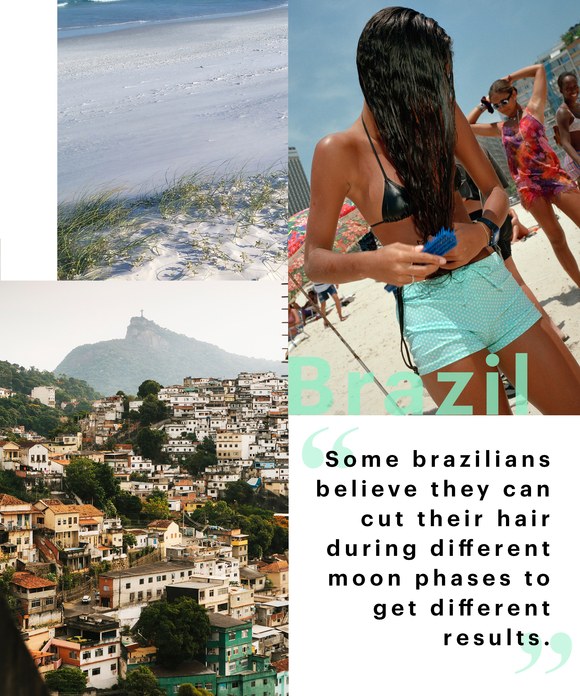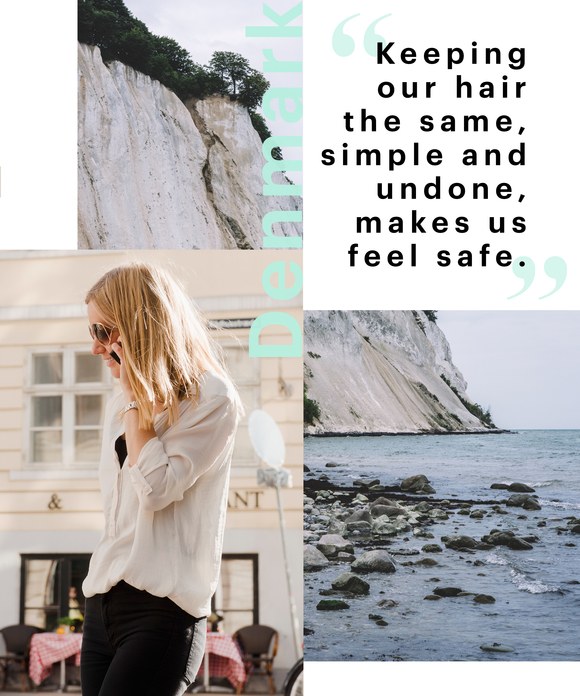|
BRAZIL
We know that moon phases affect the tides and cause 99 percent of “I’ll just have one more drink” hangovers. (We made that last one up.) (Sounds right, though.) Women in Brazil also believe it impacts their hair. “I try to trim my hair once a month when it’s a full moon,” says São Paulo–born Victoria’s Secret model Lais Oliveira. If it sounds like superstition, that’s because it is. “Brazilians are a very superstitious people in general, and they believe that they can cut their hair during different moon phases to get different results,” says Valeria Cole, the founder of Teadora, a hair- and skin-care line that uses natural ingredients found in the rain forests of Brazil (like maracujá, pitanga, and buriti). “A new moon strengthens the strands, a crescent moon accelerates growth and increases shine, and a full moon means more volume. My mom believed this with all of her heart and would scold me for cutting my hair whenever I wanted.” Moon phases aside, Brazilians also have to worry about sand, sun, and seawater turning their hair — which is often naturally curly — dry, frizzy, and brittle. “Women in Brazil do a lot of keratin treatments to hydrate their hair,” Oliveira says. “Keratin treatment” is a catchall term, though, that can mean anything from deep conditioners to far more noxious formulas. The legend goes that once upon a time an embalmer in Brazil found that the formaldehyde he used on corpses also straightened their hair. Brazilian women’s desire for straight hair ran so deep that the carcinogen was soon incorporated into salon treatments, called escova progressiva (progressive blow-dry). They eventually migrated to the U.S. — we’re guessing you’ve heard of the Brazilian blowout. “Many of the formulas made by Brazilian Blowout and other companies are now formaldehyde-free,” says Cole. “But definitely not all.” Cole recommends an entirely innocuous Brazilian hair-smoothing technique that long pre-dates the escova progressiva: “Touca de cabelo has been passed down for generations. You pin your hair tightly to your head and then cover it with an old stocking overnight. In the morning, it’s perfectly straight and super soft.” Brazilian blogger Camila Coutinho’s favorite hair smoother is a conditioning cocktail of protein, keratin, and vitamin B5. “It’s created in a hair salon called SpaDios in São Paulo,” she says. SpaDios’s menu also includes laser treatments, scalp suctioning, and velaterapia — a popular local tradition that involves twisting the hair in small sections and running the flame of a candle along the length of it to burn off split ends. For at-home split-end mending, Cole looks to a simple Brazil-nut-oil treatment or a DIY chocolate mask (combine cocoa with cornstarch and water), which we imagine smells a hell of a lot better than burning hair. If this all sounds a little high-maintenance, that’s because it is. Brazil has one of the largest hair-care markets in the world. In 2014, Brazilian women collectively spent more than $7 billion on their hair. One study found that Brazilian women use three times as many post-treatment products as American women. One particularly popular option is “combing cream,” a detangler-and-styling-cream mash-up that’s great for coddling curls. (You can now find a few options on our shores: We like Pantene Pro-V Moisturizing Combing Crème, $5.) And curl coddling is something Brazilians are doing a lot more of lately. “Hair straightening has always been very popular in Brazil, but over the last few years, a black-consciousness movement has developed, with street celebrations of kinky and curly hair as a political act,” says sociologist Chelsea Johnson. “There’s a new market for curly-hair products.” A version of this article originally appeared in the March 2018 issue of Allure. INDIA
The next time a Bollywood actress invites you over for a girls’ night, take a big whiff of the kitchen. Smell that? It’s fresh flowers and coconut. They’re staples in the DIY hair masks that most Indian women are cooking up from a young age, says model Natasha Ramachandran, who is from Pune. “Indian women are gifted with thick, healthy hair. In order to keep our scalps hydrated and nourished, we use coconut- and almond-oil masks. My mother, my grandmother, my aunt, my sisters — we all grew up doing it.” Model Rasika Navare, also originally from Pune, massages coconut oil through the length of her hair once a week as well; sometimes she switches in organic argan or rose hip oil. “Hair is one of the most important aspects of beauty in Indian culture,” she says. “People around the world love thick, long Indian hair...and we know it.” Indian women have had deep ties to their hair for centuries. A lot of their practices stem from the Hindu religion (practiced by about 85 percent of the country), and many begin at birth. Some Hindu families will ceremoniously shave the heads of their children — a tradition called chuda-karana — in order to clear them of impurities and start fresh. The sacrifice of hair is key in the Hindu religion, and many make pilgrimages to temples to offer their hair — cut from the scalp — in exchange for a blessing or as a sign of devotion. Braids are common for very devout Hindu women, and usually only widows leave their hair down. Unbound hair is associated with “loose” women (yikes). Young Hindu girls traditionally wear two pigtail braids and then transition into womanhood with a single long braid. But times are changing, and in 2018 these strict Hindu practices aren’t as common. Unless a woman is from a very traditional orthodox family, a single braid or updo isn’t necessary, and she can wear that famous thick, dark Indian hair in whatever way she pleases — and that includes Westernized styles like bobs and colors like...purple. But travel to rural India and you’ll likely still see that long, glossy braid down the back of a Hindu woman. And then there’s the beautiful Indian vegetation. Imagine flowers in every vivid tropical color of the spectrum — violet dahlias! Rich marigolds! Delicate pink lilies! It’s a literal garden of hair accessories, and women take advantage of the sweet smells and brilliant colors to add flair to their hairstyles for special occasions. And to imbue them with special meaning. Many women in Tamil Nadu, in southern India, fasten a string of jasmine to their hair as a symbol of good fortune. Did we mention their hair must smell incredible? I think we did. A version of this article originally appeared in the March 2018 issue of Allure. DENMARK
“We are, in a way, a very uniform people. Keeping our hair the same, simple and undone, makes us feel safe,” says Copenhagen-based makeup artist Marie Thomsen. “It’s a way of showing the world that we have things under control, that we are feminine but strong.” And you’re unlikely to see a Drybar Copenhagen any time soon. “I don’t think I know anyone who does a real blowout, even when going out,” says Thomsen, who washes her hair (at home) twice a week and fills the gap with Klorane dry shampoo ($20) and a little texturizing spray. Think effortless Parisian beauty, but with even more minimalism — and a dash of hygge. “We use a lot of thick conditioners and hair masks,” says stylist Pernille Teisbaek, who relies on Kevin Murphy’s line of hair products. But there aren’t a lot of homespun recipes being passed down through the generations. “My family didn’t teach me about what to do with my hair growing up, but that’s the point,” says fashion blogger Marie Hindkær. “Danish women don’t want people to think they spend a lot of time on their hair.” Hindkær describes her fine, super straight texture as “typical Scandinavian hair.” A blast of volumizer (she likes Maria Nila Volume Spray, $31) and a touch of Moroccanoil is all she’ll admit to using. It doesn’t take more than a minute. Really. A version of this article originally appeared in the March 2018 issue of Allure. It started — as most things do — with evolution. Warmth. Protection. Perhaps even camouflage. Since then our hair has become a signifier of religion. Of political status. Of gender. Of race. A reflection of who we are. The way we treat and style our hair can speak to where we come from as much as a language or an accent or a total lack of patience on a subway platform. That’s partly because we nurture and celebrate our hair with the tools at hand: red ochre hair dye in Africa, a kaleidoscope of colored flowers in India, rain-forest-foraged ingredients in Brazil. And it’s partly because, perhaps more than any other beauty conventions, hair rituals are passed down through generations. We asked women from four corners of the globe to share some of the secrets most ingrained in their native cultures. And there are only a few thousand more where these came from. ETHIOPIA
“Ethiopian women love butter,” says model and activist Gelila Bekele, who was born in Addis Ababa. For centuries, women in Ethiopia have relied on raw, unsalted butter to nourish dry hair. “Moisture for black hair has taken myriad forms depending on availability and location,” says Noliwe Rooks, an associate professor of Africana and feminist, gender, and sexuality studies at Cornell University. “Coconut oil, ghee, and Vaseline were all key depending on where one was in the African diaspora. In some cultures, mud and clay are used to lock in moisture.” Bekele still uses raw butter in her hair today. “I apply it directly to my scalp once a week, massaging until the butter melts, and let it sit for a few hours or overnight. And the benefits are beyond hair care — it moisturizes skin.” Of course, with so much diversity within the country, there are tons of hair secrets to mine. “Ethiopia has over 80 different ethnic groups; hair signifies something different to each tribe,” says Bekele. “They all have their own special traditions, like brides wearing silver or gold beads, partially shaved heads with intricate braids to signify youth, or using red clay to twist the hair or paint scalps.” And many women in Ethiopia dye their hair, but not with foil strips and chemical fumes. Women from the Hamer tribe use raw butter and fresh ochre, made of red clay paste, to paint their hair a deep terracotta color. They then twist their newly colored hair into thin locs called goscha. The twists are meant to signal health and vitality. Many of the hairstyles in Ethiopia are so intricate that women have even been known to preserve them by sleeping on a wooden headrest. A version of this article originally appeared in the March 2018 issue of Allure. FOR IMMEDIATE RELEASE |
Hair by BrianMy name is Brian and I help people confidently take on the world. CategoriesAll Advice Announcement Awards Balayage Barbering Beach Waves Beauty News Book Now Brazilian Treatment Clients Cool Facts COVID 19 Health COVID 19 Update Curlies EGift Card Films Follically Challenged Gossip Grooming Hair Care Haircolor Haircut Hair Facts Hair History Hair Loss Hair Styling Hair Tips Hair Tools Health Health And Safety Healthy Hair Highlights Holidays Humor Mens Hair Men's Long Hair Newsletter Ombre Policies Procedures Press Release Previous Blog Privacy Policy Product Knowledge Product Reviews Promotions Read Your Labels Recommendations Reviews Scalp Health Science Services Smoothing Treatments Social Media Summer Hair Tips Textured Hair Thinning Hair Travel Tips Trending Wellness Womens Hair Archives
June 2025
|
|
Hey...
Your Mom Called! Book today! |
Sunday: 11am-5pm
Monday: 11am-6pm Tuesday: 10am - 6pm Wednesday: 10am - 6pm Thursday: By Appointment Friday: By Appointment Saturday: By Appointment |






 RSS Feed
RSS Feed